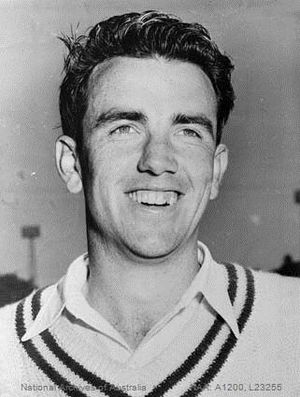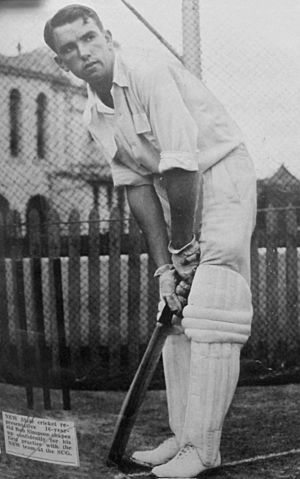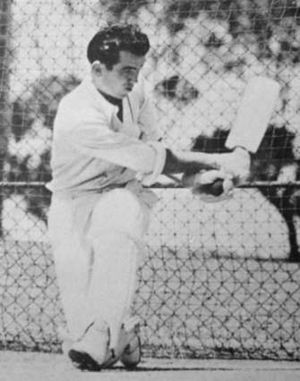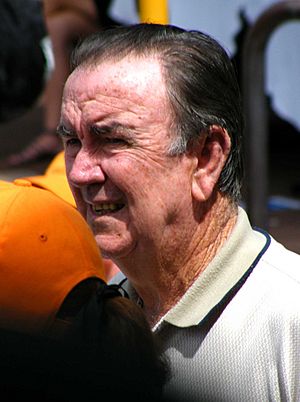Bob Simpson (cricketer) facts for kids

Simpson in 1957
|
||||||||||||||||||||||||||||||||||||||||||||||||||||||||||||||||||
| Personal information | ||||||||||||||||||||||||||||||||||||||||||||||||||||||||||||||||||
|---|---|---|---|---|---|---|---|---|---|---|---|---|---|---|---|---|---|---|---|---|---|---|---|---|---|---|---|---|---|---|---|---|---|---|---|---|---|---|---|---|---|---|---|---|---|---|---|---|---|---|---|---|---|---|---|---|---|---|---|---|---|---|---|---|---|---|
| Full name |
Robert Baddeley Simpson
|
|||||||||||||||||||||||||||||||||||||||||||||||||||||||||||||||||
| Born | 3 February 1936 Marrickville, New South Wales, Australia |
|||||||||||||||||||||||||||||||||||||||||||||||||||||||||||||||||
| Died | 16 August 2025 (aged 89) | |||||||||||||||||||||||||||||||||||||||||||||||||||||||||||||||||
| Nickname | Simmo | |||||||||||||||||||||||||||||||||||||||||||||||||||||||||||||||||
| Height | 179 cm (5 ft 10 in) | |||||||||||||||||||||||||||||||||||||||||||||||||||||||||||||||||
| Batting | Right-handed | |||||||||||||||||||||||||||||||||||||||||||||||||||||||||||||||||
| Bowling | Right-arm leg spin | |||||||||||||||||||||||||||||||||||||||||||||||||||||||||||||||||
| Role | Batsman | |||||||||||||||||||||||||||||||||||||||||||||||||||||||||||||||||
| International information | ||||||||||||||||||||||||||||||||||||||||||||||||||||||||||||||||||
| National side |
|
|||||||||||||||||||||||||||||||||||||||||||||||||||||||||||||||||
| Test debut (cap 209) | 23 December 1957 v South Africa | |||||||||||||||||||||||||||||||||||||||||||||||||||||||||||||||||
| Last Test | 3 May 1978 v West Indies | |||||||||||||||||||||||||||||||||||||||||||||||||||||||||||||||||
| ODI debut (cap 44) | 22 February 1978 v West Indies | |||||||||||||||||||||||||||||||||||||||||||||||||||||||||||||||||
| Last ODI | 12 April 1978 v West Indies | |||||||||||||||||||||||||||||||||||||||||||||||||||||||||||||||||
| Domestic team information | ||||||||||||||||||||||||||||||||||||||||||||||||||||||||||||||||||
| Years | Team | |||||||||||||||||||||||||||||||||||||||||||||||||||||||||||||||||
| 1952/53–1955/56 | New South Wales | |||||||||||||||||||||||||||||||||||||||||||||||||||||||||||||||||
| 1956/57–1960/61 | Western Australia | |||||||||||||||||||||||||||||||||||||||||||||||||||||||||||||||||
| 1961/62–1977/78 | New South Wales | |||||||||||||||||||||||||||||||||||||||||||||||||||||||||||||||||
| Head coaching information | ||||||||||||||||||||||||||||||||||||||||||||||||||||||||||||||||||
| Years | Team | |||||||||||||||||||||||||||||||||||||||||||||||||||||||||||||||||
| 1986–1996 | Australia | |||||||||||||||||||||||||||||||||||||||||||||||||||||||||||||||||
| 1999–2001 | Lancashire | |||||||||||||||||||||||||||||||||||||||||||||||||||||||||||||||||
| Career statistics | ||||||||||||||||||||||||||||||||||||||||||||||||||||||||||||||||||
|
||||||||||||||||||||||||||||||||||||||||||||||||||||||||||||||||||
|
Medal record
|
||||||||||||||||||||||||||||||||||||||||||||||||||||||||||||||||||
|
Source: CricketArchive, 14 April 2008
|
||||||||||||||||||||||||||||||||||||||||||||||||||||||||||||||||||
Robert Baddeley Simpson, known as Bob Simpson or Simmo, was a famous Australian cricketer. He was born on February 3, 1936, and passed away on August 16, 2025. Bob played for New South Wales and Western Australia. He also captained the Australian national team from 1963 to 1968 and again in 1977-1978. After his playing career, he became a very successful coach for the Australian team.
Bob Simpson was an excellent right-handed batsman and a good leg spin bowler. He was also an amazing fielder, known for catching many balls. After retiring for ten years, he made a surprising comeback at age 41 to lead Australia during a special time in cricket history called World Series Cricket.
From 1986 to 1996, Bob Simpson coached the Australian team. Under his guidance, the team changed from struggling to becoming one of the strongest in the world. Some of their biggest wins during his time as coach included the 1987 Cricket World Cup, winning The Ashes in England in 1989, and beating the strong West Indies team in their home country in 1995. He also coached cricket clubs in England.
Contents
Early Life and Cricket Beginnings
A Talented Youngster
Bob Simpson was born in Marrickville, New South Wales, a suburb of Sydney. His parents were immigrants from Scotland. Bob grew up with two older brothers, Bill and Jack. His brothers encouraged him to play cricket from a young age.
Bob started his cricket journey as a fast bowler and batsman. He showed leadership skills early on, captaining his primary and high school teams. He even captained a team of 14-year-olds when he was only 12! Besides cricket, Bob was also good at golf, baseball, and soccer. He was known for being confident and determined.
At 12, Bob was chosen to play for New South Wales in an Under-14 competition. When he was 13, he changed his bowling style to leg spin. Just after turning 15, he was playing for Petersham's top team in Sydney Grade Cricket.
First Steps in First-Class Cricket
Bob Simpson was almost 17 when he played his first Sheffield Shield match for New South Wales in 1952-1953. He was one of the youngest players for New South Wales. He scored well and took his first wicket. After a few seasons, he moved to Western Australia to get more opportunities to play.
Becoming an International Star
Early Test Matches
After some top Australian players retired, new spots opened up in the national team. Bob Simpson was chosen for an Australian team that toured New Zealand in 1956-1957.
The next season, Bob was selected for the Test tour of South Africa in 1957-1958. This earned him his first Test match for Australia against South Africa in Johannesburg. He scored 60 runs and took three catches. His great catching helped him stay in the team.
Finding His Place as an Opener
Bob worked hard to improve his batting and decided to become an opening batsman. In the 1959-1960 season, he had a fantastic time playing for Western Australia, scoring two double centuries. These performances helped him get back into the national team.
The Famous Tied Test
Bob Simpson was called back to the Test team for the 1960-1961 series against the West Indies. He opened the batting with Colin McDonald. In the First Test in Brisbane, Bob scored 92 runs and took 3 wickets. This match became the first-ever Tied Test in cricket history, a thrilling game where both teams scored the same number of runs!
In the deciding Fifth Test in Melbourne, Australia needed 258 runs to win. Bob's captain, Richie Benaud, told him to attack the West Indies' fast bowler, Wes Hall, right away. Bob hit four boundaries in the first over, scoring 18 runs very quickly. This aggressive start helped Australia win the match and series.
In 1961, Bob Simpson started a famous opening partnership with Bill Lawry. They became one of the best opening pairs in Test history. Bob continued to score consistently and take wickets.
Leading the Australian Team
Taking on the Captaincy
At the start of the 1963-1964 season, Bob became the vice-captain for Australia. He started the season with an incredible 359 runs, his highest first-class score. He also scored two other double centuries.
When captain Richie Benaud was injured, Bob Simpson led Australia for the first time in a Test match in Melbourne. Australia won that match. Benaud later decided to retire, so Bob was chosen to be the new full-time captain of Australia. He led a young team, as many experienced players had retired.
A Record-Breaking Triple Century
In 1964, Bob Simpson led the Australian team to England. In the Fourth Test at Old Trafford, Australia needed to draw the match to keep the Ashes. Bob decided to bat for a very long time to make sure England couldn't win. He and Bill Lawry had a great opening partnership.
Bob kept batting and batting, eventually scoring an amazing 311 runs! This innings lasted for 13 hours. Bob Simpson became only the second Australian to score a triple century in England, after the legendary Don Bradman. He was also only the second player to score a triple century as his first Test century. This long innings helped Australia draw the match and keep the Ashes.
Captaining Against Tough Opponents
After the England tour, Australia played Tests against India and Pakistan. Bob continued his strong performances, scoring centuries and taking wickets. He became the third captain to score two centuries in the same Test. In 1964, he set a world record for the most Test runs scored in a single calendar year.
Bob led Australia on a challenging tour of the Caribbean, where he scored 201 runs in one Test and set an Australian record opening partnership of 382 runs with Lawry. He also led Australia to retain the Ashes in 1965-1966.
International Twilight
During the 1967-1968 series against India, Bob Simpson had outstanding all-round performances, scoring two centuries and taking many wickets. Bob decided to retire at the end of this season. In his final match, he played under Bill Lawry, taking his best Test bowling figures.
Retirement and a Surprising Comeback
Stepping Away from the Game
After retiring from Test cricket, Bob Simpson worked in public relations and as a cricket journalist. He helped cricketers earn money from promotions and marketing.
Return to the Test Arena
In 1977, a new cricket competition called World Series Cricket started, which changed the game. Many of Australia's top players joined this new league. Because of this, Bob Simpson, at 41 years old, made a surprising comeback to captain New South Wales and Australia. He had not played top-level cricket for a decade.
His first challenge was a five-Test series against India. Bob showed he still had it! He scored a century and high scores, helping Australia win the series. After this, he led Australia on a tour of the West Indies, who were the strongest team in the world at the time. Bob Simpson retired again after this tour, at the age of 42. He had scored over 10,000 runs in Sydney Grade Cricket.
Bob Simpson's Cricket Style
Batting and Fielding Skills
Bob Simpson was known for his excellent batting technique. He was not very tall, but he could bat for a long time due to his fitness and focus. He had many different shots. His opening partnership with Bill Lawry was considered one of the best in Test history. They were good at running between wickets and understood each other well. Bob's batting style was attractive, and he was known for his straight-drive and powerful square-cut shots.
A Disciplined Leader
As a bowler, Bob Simpson mainly used leg-breaks. He took 71 wickets in Test matches, including two times when he took five wickets in an innings. In all first-class matches, he took 349 wickets.
Bob was an outstanding fielder, especially in the slips position. He was considered the best fielder of his time. He took 110 catches in Test matches, which was a world record. His rate of 0.94 catches per innings is still the highest for any non-wicketkeeper fielder.
As Australia's Test captain, Bob Simpson was known for being very disciplined and tough. He believed in hard work and that the team's needs came before any individual player.
Coaching Australia to Success
Building a Winning Team
In 1986, Bob Simpson became the coach of the Australian team. At that time, the team was young and struggling, not having won a Test series for two years. Bob and captain Allan Border worked hard to change this.
World Cup and Ashes Victories
The 1987 Cricket World Cup was a turning point for Australian cricket. Australia surprised everyone, despite low expectations. They won close matches and eventually defeated England in the final, winning the World Cup!
This success carried over into Test cricket. In 1989, Australia won The Ashes in England. This series also saw Mark Taylor become a key player, later captaining under Simpson.
Continued Dominance
The Australian team kept getting stronger under Simpson's coaching. They won another Ashes series in 1990-1991. In 1995, they finally won the Frank Worrell Trophy by beating the West Indies in the Caribbean, establishing themselves as the best Test team in the world. After this historic win, Mark Taylor gave the winning cricket ball to Bob Simpson.
New talented players like Mark Waugh, Shane Warne, Michael Slater, and Glenn McGrath joined the team during this time. These players became key to Australia's success. Shane Warne brought back the art of leg spin bowling, and Glenn McGrath became one of the best fast bowlers in Test history.
Bob Simpson's last coaching role for Australia was at the 1996 Cricket World Cup. Australia reached the final but lost to Sri Lanka.
Later Coaching Roles and Legacy
After coaching Australia, Bob Simpson coached cricket clubs in England. He also advised a team in India and coached the Netherlands national cricket team, helping them qualify for the 2007 Cricket World Cup.
Bob Simpson was a traditional coach who focused on the basic skills of batting, bowling, and fielding. He believed in hard work and discipline. By the time he retired from coaching in 1996, Australia had become the world's leading Test nation, largely thanks to his efforts.
Passing and Honours
A Life of Achievements
Cricket Australia confirmed Bob Simpson's passing on August 16, 2025, at the age of 89.
Bob Simpson received many awards for his contributions to cricket. He was named a Wisden Cricketer of the Year in 1965. He was inducted into the Sport Australia Hall of Fame in 1985, the Australian Cricket Hall of Fame in 2006, and the ICC Cricket Hall of Fame in 2013.
He was also recognized with national honors, becoming a Member of the Order of Australia in 1978 and an Officer of the Order in 2007. He received the Australian Sports Medal in 2000 and a Centenary Medal in 2001.
See also
 In Spanish: Bob Simpson para niños
In Spanish: Bob Simpson para niños






